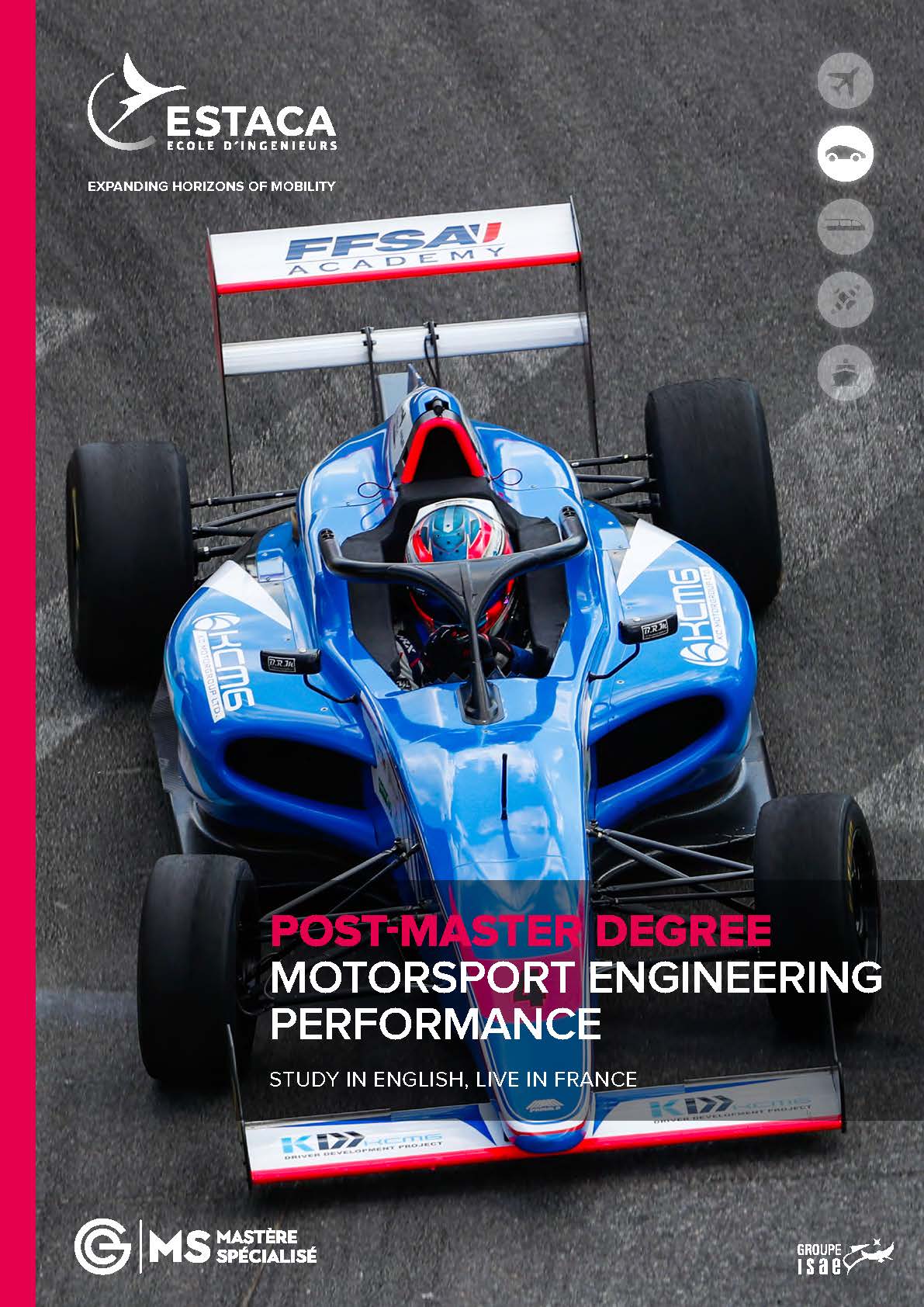PROGRAM IN BRIEF
Aim
Acquire the skills to:
- Design, optimize and organize all the technical solutions;
- Master and implement product manufacturing methods;
- Take account of the productivity and quality imperatives of the Motorsport sector.
Program benefits
- Teaching faculty heavily involved in the industrial sector;
- Concrete and practical project-based approach.
Skills acquired
- Identify the different categories, race tracks and regulations in motorsport;
- Use sensors, analyze signals, video imaging, use chassis or engine data acquisition analysis methods, adjust a chassis or engine, make recommendations;
- Identify race vehicle architecture, make and analyze dimensioning calculations, pilot and analyze mechanical tests, propose new solutions, optimise a structure, get to know “new” materials;
- Define aerodynamic principles, identify aerodynamic phenomena, conduct and analyze wind tunnel tests, use CFD for analysis, organize track trials;
- Identify the architecture of a combustion engine, an electric, hybrid and hydrogen engine;
- Analyze gearbox technology;
- Identify the materials used in tyres, analyze tyre behavior, analyze the impact of tyres on performance;
- Analyze pilot behavior, identify track safety;
- Manage projects, write reports, communicate and speak in public.
480 hours of academic coursework: September to February
6 months minimum of in-company operational training followed by a professional thesis defense (March to August).
Assessment
- Teaching modules assessed via exams and case studies;
- Academic project & Professional thesis assessed via dissertation.
JOB PROSPECTS
- Engineering: chief designer, engineer, structural engineer;
- Aerodynamics: CFD engineer, wind tunnel engineer, aerodynamic track engineer, design of (new) models;
- Engines: chief engineer, engine support engineer;
- Track operations: operating engineer, data engineer, performance engineer, track support engineer;
- R&D: department manager/R&D activity, R&D engineer;
- Management: technical director, technical project manager.
Course breakdown: Lectures, case studies, team work project and management.
Language: English
Number of credits: 75 ECTS
CURSUS
PROGRAM
Note: the above program might be subject to minor changes.
INTRODUCTION TO MOTORSPORT
Data processing with Matlab
Basic network architecture and electronics
Introduction to thermal engine and gearbox
Driver coaching and driving (FFSA)
Analysis of data on a simulator (WINTAX)
Operating a Formula 4 on track (FFSA)
Track safety
English for Motorsport
100 Student Hours - 7 ECTS
DESIGN OF A RACING VEHICLE: THE FUNDAMENTALS
Regulation analysis and impact on the race car design
Basic of car racing aerodynamics
Basics in tyre knowledge
Basic vehicle dynamics knowledge and performance parameters
Basic embedded systems
70 Student Hours - 6 ECTS
RACING VEHICLE AERODYNAMICS
Basic aerodynamics
Completion, analysis and CFD optimization
Monitoring, completion and wind tunnel test analysis
Wind tunnel labwork
70 Student Hours - 6 ECTS
POWERTRAIN DEVELOPMENT
Thermal engine structure
Transmission and gearbox
Electric motor architecture and energy storage
Hydrogen engine
Hybrid process and monitoring systems
Impact fuel on the ICE design
60 Student Hours – 5 ECTS
OPERATIONS ON RACING CIRCUITS
Recommendations and a typical vehicle fine-tuning Pilot’s behavior analysis
Organizing a team on the track
Race event preparation
Sensor and data acquisition in race vehicules
Development of realibility and performance analysis tools (Motec)
Race strategy on Trackside software
Driver behaviour analysis on ESTACA simulator
Race preparation on a circuit, in collaboration with students of the Meka association
90 Student Hours - 6 ECTS
INDUSTRIAL PROJECT
200 Student Hours - 15 ECTS
PROFESSIONAL THESIS
110 Student Hours - 10 ECTS
IN COMPANY OPERATIONAL TRAINING
24 Weeks - 20 ECTS
PROGRAM DESIGNED JOINTLY WITH INDUSTRIAL PARTNERS, INCLUDING ORECA, THE FRENCH FLAGSHIP MOTOR RACING COMPANY
This training course has been developed in partnership with ORECA, a leadingedge French company in the design and manufacturing of racing cars. It covers the construction of the program, joint teaching of course modules, the availability of business experts and the team premises for “projects”. With this partnership, ORECA and ESTACA aim to meet the human, technical and operational needs of companies working in the competitive motorsports sector.
Among the companies and federations involved in the program are the FIA, Renault Sport Racing, Automobile Club de l’Ouest and Peugeot Motorsport
STUDY CLOSE TO MOTORSPORTS RACING CIRCUITS - TWO SITES FOR ONE PROGRAM: ESTACA LAVAL AND LE CASTELET
Classes in the Motorsport Engineering Performance Post-Master’s Degree are held on two sites. Part of the course is given at ’ESTACA LAVAL, in the Mayenne department (1½ hours from Paris by TGV), 30 minutes from the Le Mans race track. Part of the course is given at the FFSA Academy at Le Mans.
ELIGIBILITY
This program is open to all foreign and French students holding a Master Degree (preferably in scientific fields, business master may also apply).
Applicants proving 3 years of professional experience should have completed four years of studies in an engineering (Master Level ot Advanced Bachelor). Applicants should have English language proficiency (TOEFL iBT: 91, TOEIC: 850 or IELTS: 6.5).
Tuition fees
Full Fees: 16 000€ (Euros)
Reduced fees: 14 000€ (Euros) for students graduating in the year of enrollment. For ESTACA Alumni, please contact
Admission process
Admission upon application, possibly with an interview.
- Application Form available on the website: www.admissions.estaca.fr
- Application period: application is to be sent before May 30th for non-european students (visas requirements) and September 8th for European students.
APPLICATION
How to register to the Post-Master degree MOTORSPORT engineering and performance
1° Create your account
2° Once you have validate your account : Log in
3° Access the registration form on the menu "My Registration". Complete the form with all the mandatory informations and documents.
Only complete Application form will by evaluated.














